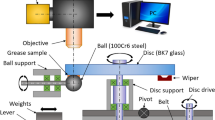Abstract
The accumulated damage process of rolling contact fatigue (RCF) of plasma-sprayed coatings was investigated. The influences of surface roughness, loading condition, and stress cycle frequency on the accumulated damage status of the coatings were discussed. A ball-ondisc machine was employed to conduct RCF experiments. Acoustic emission (AE) technique was introduced to monitor the RCF process of the coatings. AE signal characteristics were investigated to reveal the accumulated damage process. Result showed that the polished coating would resist the asperity contact and remit accumulated damage. The RCF lifetime would then extend. Heavy load would aggravate the accumulated damage status and induce surface fracture. Wear became the main failure mode that reduced the RCF lifetime. Frequent stress cycle would aggravate the accumulated damage status and induce interface fracture. Fatigue then became the main failure mode that also reduced the RCF lifetime.
Similar content being viewed by others
References
Xu B, Wang H, Ma G. Advanced surface engineering technologies for remanufacturing forming. Rare Metal Materials and Engineering, 2012, (S1): 1–5 (in Chinese)
Xu B, Fang J, Dong S, et al. Heat-affected zone microstructure evolution and its effects on mechanical properties for laser cladding FV520B stainless steel. Acta Metallurgica Sinica, 2016, 52(1): 1–9 (in Chinese)
Zivelonghi A, Weitkamp T, Larrue A. Open porosity and 3D pore architecture in plasma-sprayed tungsten. Scripta Materialia, 2016, 115: 66–70
Zhang C, Wang J, Geng X. Tungsten oxide coatings deposited by plasma spray using powder and solution precursor for detection of nitrogen dioxide gas. Journal of Alloys and Compounds, 2016, 668: 128–136
Ahmed R. Contact fatigue failure modes of HVOF coatings. Wear, 2002, 253(3–4): 473–487
Stewart S, Ahmed R. Contact fatigue failure modes in hot isostatically pressed WC-12%Co coatings. Surface and Coatings Technology, 2003, 172(2–3): 204–216
Stewart S, Ahmed R, Itsukaichi T. Contact fatigue failure evaluation of post-treated WC-NiCrBSi functionally graded thermal spray coatings. Wear, 2004, 257(9–10): 962–983
Stewart S, Ahmed R, Ituskaichi T. Rolling contact fatigue of posttreated WC-NiCrBSi thermal spray coatings. Surface and Coatings Technology, 2005, 190(2–3): 171–189
Fujii M, Ma J, Yoshida A, et al. Influence of coating thickness on rolling contact fatigue of alumina ceramics thermally sprayed on steel roller. Tribology International, 2006, 39(11): 1447–1453
Fujii M, Yoshida A, Ma J, et al. Rolling contact fatigue of alumina ceramics sprayed on steel roller under pure rolling contact condition. Tribology International, 2006, 39(9): 856–862
Zhang X, Xu B, Xuan F, et al. Fatigue resistance of plasma-sprayed CrC-NiCr cermet coatings in rolling contact. Applied Surface Science, 2008, 254(13): 3734–3744
Zhang X, Xu B, Tu S, et al. Rolling contact fatigue mechanism of a plasma-sprayed and laser-remelted Ni alloy coating. Fatigue & Fracture of Engineering Materials & Structures, 2009, 32(2): 84–96
Kang J, Xu B, Wang H, et al. Competing failure mechanism and life prediction of plasma sprayed composite ceramic coating in rollingsliding contact condition. Tribology International, 2014, 73: 128–137
Kang J, Xu B, Wang H, et al. Influence of contact stress on rolling contact fatigue of composite ceramic coatings plasma sprayed on a steel roller. Tribology International, 2014, 73: 47–56
Piao Z, Xu B, Wang H, et al. Investigation of fatigue failure prediction of Fe-Cr alloy coatings under rolling contact based on acoustic emission technique. Applied Surface Science, 2011, 257 (7): 2581–2586
Piao Z, Xu B, Wang H, et al. Investigation of RCF failure prewarning of Fe-based coating by online monitoring. Tribology International, 2014, 72: 156–160
Piao Z, Xu B, Wang H, et al. Investigation of acoustic emission source of Fe-based sprayed coating under rolling contact. International Journal of Fatigue, 2013, 47: 184–188
Li G, Zhang Z, Wang H, et al. Acoustic emission monitoring and failure mechanism analysis of rolling contact fatigue for Fe-based alloy coating. Tribology International, 2013, 61: 129–137
Piao Z, Xu B, Wang H, et al. Investigation of rolling contact fatigue lives of Fe-Cr alloy coatings under different loading conditions. Surface and Coatings Technology, 2010, 204(9–10): 1405–1411
Piao Z, Xu B, Wang H, et al. Influence of surface roughness on rolling contact fatigue behavior Fe-Cr alloy coatings. Journal of Materials Engineering and Performance, 2013, 22(3): 767–773
Author information
Authors and Affiliations
Corresponding author
Rights and permissions
About this article
Cite this article
Xu, J., Zhou, Zy. & Piao, Zy. Accumulated damage process of thermal sprayed coating under rolling contact by acoustic emission technique. Front. Mech. Eng. 11, 227–232 (2016). https://doi.org/10.1007/s11465-016-0395-9
Received:
Accepted:
Published:
Issue Date:
DOI: https://doi.org/10.1007/s11465-016-0395-9




